Mini Transat: Going from zero to scary
Published on November 2nd, 2017
(November 2, 2017; Day 1) – You have to be a strange fish to do the Mini-Transat. In addition to the two years of sacrifice thinking about and shelling out cash on a Mini Class campaign, all those competing in the Mini-Transat La Boulangère are well aware that everything can come to an abrupt halt on these super-powered racing steeds to the detriment of material damage. Indeed, most of them get a little knot in their stomach the moment the wind picks up a notch. And yet…
There are not a hundred and one ways to do the Mini. Those who are in it to win it accept that they are constantly sailing with the increased threat of breakage looming over them. In order to go faster than your neighbour, the minute the wind picks up involves putting your fears to one side, pushing the envelope, brushing aside the fatigue and playing with the limits of the gear aboard.
Everyone is trying to do everything in their power to push themselves that one step further and dare to dream. What might be considered impossible at the start of the race, gradually becomes feasible, and the Mini-Transat La Boulangère shouldn’t be an exception to the rule.
Of course, in an ideal world, the weather conditions will be consistent with this rise in power. However, the very nature of offshore racing is that the sea is the only judge. For this second leg, it’s been a quick transition for the skippers. After a gentle start, the wind has quickly picked up to 25 knots, enabling the Minis to power along southwards.
In these conditions, the toughest skippers have immediately stepped up to the plate and are showing what they’re made of. Among these we have the usual suspects of course, like Ian Lipinski (Griffon.fr) and Erwan Le Mené (Rousseau Clôtures), who are continuing their duel from the first leg.
Alongside them, really coming into their own in this second leg, are Jörg Riechers (Lilienthal), Romain Bolzinger (Spicee.com) and Simon Koster (Eight Cube Sersa). A number of others are on the hunt too, like Patrick Jaffré (Projet Pioneer) and Charlotte Méry (Optigestion – Femmes de Bretagne), who are very much in the action.
In the production boat category, there is so little separating the boats that more often it’s the lateral separation in relation to the direct route that determines the ranking. Less than 10 miles separate the top eight and it would be a tough ask to predict who will be first down the channel between the Cape Verde islands of Santo Antao and Sao Vicente.
In this way, after leading the way for a while, Tanguy Bouroullec (Kerhis – Cerfrance) is now paying for his coastal option. However, in offshore racing, you can sometimes reap big rewards for investing in a certain direction.
Following his dismasting last night, Dorel Nacou (Ixblues Vamonos) was quickly able to determine that aside from his mast tube splitting in two, he still has his spreaders, all his sails and his rigging. Like a shot, he decided to officially report to the nearby support boat, Grande Hermine, explaining that there was no question of him retiring.
Instead Dorel will make for the port of Boujdour to the south of Morocco. Once there he intends to effect repairs and head back out to sea to finish what he started. One would expect nothing less from this chap who, some twenty-five years earlier, decided to flee his native Romania, crossing Europe in a series of freight cars to seek refuge in Marseille.
Fellow skipper, Julien Bozzolo (Mariolle), has broken his bowsprit but he too intends to quickly effect repairs. In offshore racing, stubborn determination can sometimes be a major virtue.
Position report on 2 November at 18:00 UTC
Prototypes
1 Ian Lipinski (Griffon.fr) 2,681.6 miles from the finish
2 Erwan le Mené (Rousseau Clôtures) 8.5 miles behind the leader
3 Charlotte Méry (OptiGestion – Femmes de Bretagne) 14.5 miles behind the leader
4 Romain Bolzinger (Spicee.com) 16.5 miles behind the leader
5 Patrick Jaffré (Project Pioneer) 19.6 miles behind the leader
Production boats
1 Rémi Aubrun (Alternative Sailing – Constructions du Belon) 2,709.4 miles from the finish
2 Tanguy Bouroullec (Kerhis-Cerfrance) 0.2 miles behind the leader
3 Clarisse Crémer (TBS) 4.3 miles behind the leader
4 Erwan Le Draoulec (Emile Henry) 7.7 miles behind the leader
5 Benoit Sineau (Cachaca II) 12.0 miles behind the leader
Class news – Race news – Tracking – Facebook
Race Facts
· 21st edition
· 4,050 miles to cover between La Rochelle – Las Palmas in Gran Canaria and Le Marin (Martinique)
· 81 skippers at the start
· 10 women
· 11 nationalities
· 20 years: age of the youngest skipper in the race: Erwan Le Draoulec
· 62 years: age of the oldest skipper in the race: Fred Guérin
· 25 prototypes
· 56 production boats
· 66 rookies
· 15 ‘repeat offenders’
Background
With an overall length of 6.50m and a sail area pushed to the extreme at times, the Mini Class offers incredibly seaworthy boats. Subjected to rather draconian righting tests and equipped with reserve buoyancy making them unsinkable, the boats are capable of posting amazing performances in downwind conditions… most often to the detriment of comfort, which is rudimentary to say the least.
The Mini Transat has two legs to carry the fleet from La Rochelle, France to Martinique, West Indies. The leg from La Rochelle to Las Palmas de Gran Canaria is a perfect introduction to proceedings before taking the big transatlantic leap.
The first leg starts on October 1, with the fleet thrust into the Bay of Biscay which can be tricky to negotiate in autumn, while the dreaded rounding of Cape Finisterre on the north-west tip of Spain marks a kind of prequel to the descent along the coast of Portugal. Statistically, this section involves downwind conditions, often coloured by strong winds and heavy seas. Making landfall in the Canaries requires finesse and highly developed strategic know-how.
The second leg begins on November 1, with the solo sailors most often carried along by the trade wind in what tends to be a little over two weeks at sea on average. Due to a storm, the fleet is being routed south to Cape Verde before heading west. At this point, there’s no way out: en route to the West Indies, there are no ports of call. The sailors have to rely entirely upon themselves to make Martinique.
Source: Aurélie BARGAT | Effets Mer


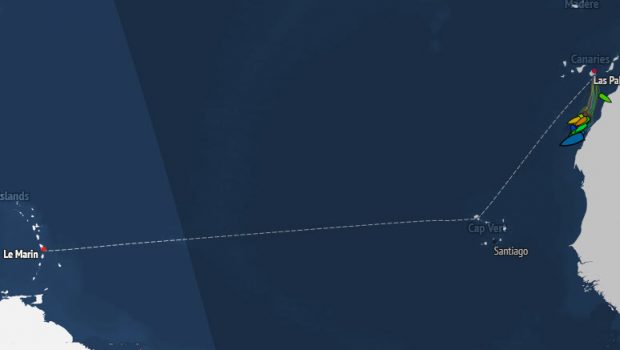

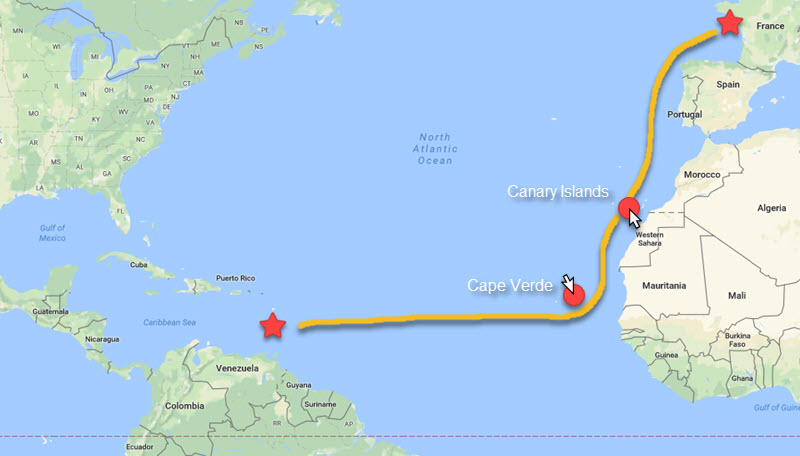


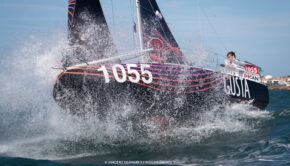
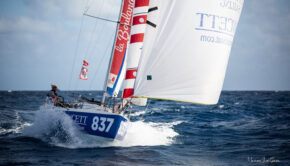
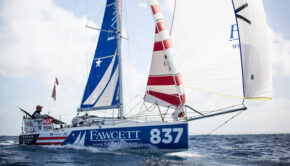
 We’ll keep your information safe.
We’ll keep your information safe.